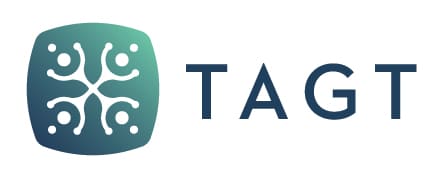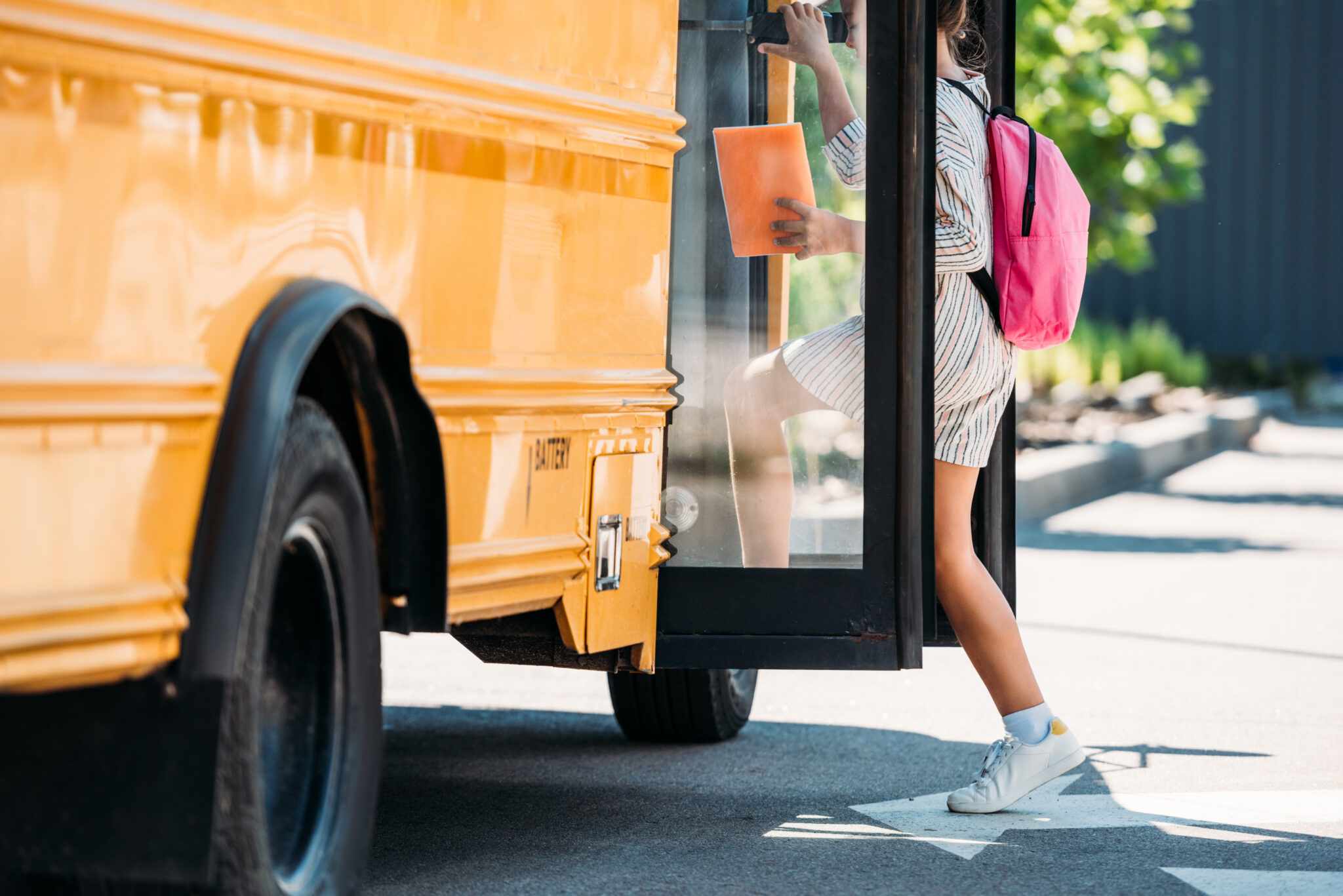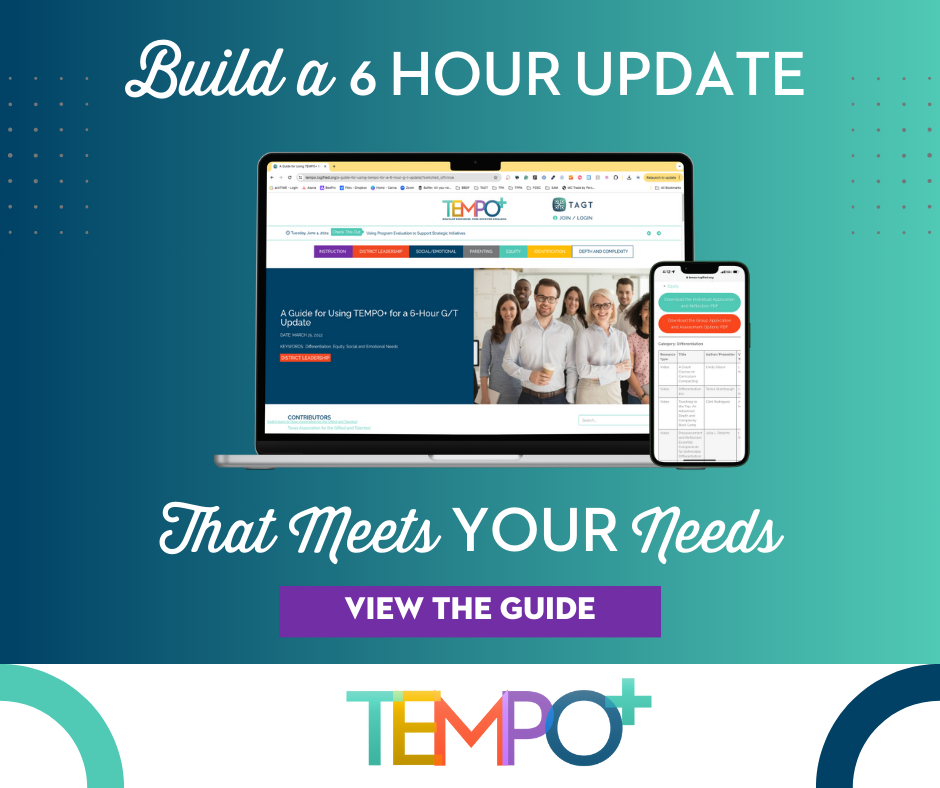Time and money. Two important considerations for Professional Learning (PL). Are these the only considerations? If the district or campus has the money to address PL needs and can find the time required, do participants come away with new learning and the ability to apply what they have learned? Does their learning translate into student growth?
The process of PL goes beyond time and money to include best practice based on experience and most current research. The role of the gifted educator in this process is to create long-term change in participants. Change occurs through facilitation prior to and during the selected PL, follow-up after completion of PL, and long-term implications for student academic growth.
Any discussion of PL also includes systems of delivery that broaden the process. Systems include face-to-face, online, and blended models. Focus on specific questions within each system guides the educator in the selection of successful PL.
Important essentials of PL to remember in Texas are alignment with the District and Campus Improvement Plans (DIP/CIP) and requirements within the Texas State Plan for the Education of the Gifted/Talented (Texas Education Agency [TEA], 2009) for both 30-hour and 6-hour PL updates.
This article addresses PL that is designed by a G/T educator or any district personnel responsible for its delivery and follow-up. For simplicity, the term educator, whether teacher, coordinator, or administrator, is used. The role of an educator in PL encompasses experience, research, and practice that ensures quality of content, quality delivery, and follow-up for long-term learning and student success.
Research
Research, theory, and practice offer insight into effective PL. A summary of research focuses on three primary findings:
- Knowledge and skills increase to change observable classroom practices (Desimone, Porter, Garet, & Birman, 2002). Although skills and concepts are a part of PL, they are not its core. Ongoing PL remains essential for growth of educators’ skills leading to enhanced student learning. The goal of PL rests in its influence on student growth.
- Professional learning:
- meshes with the work of teaching;
- aligns with school goals, state and district standards and assessment, and other professional learning activities;
- focuses on core content and modeling of teaching strategies for the content;
- includes opportunities for active learning of new teaching strategies;
- provides the chance for teachers to collaborate;
- includes follow-up and continuous feedback; and
- is intended to improve student learning (DeMonte, 2013, p. 1).
- Focus on content knowledge, active learning, and consistency with other learning activities (Desimone et al., 2002).
The above-mentioned sources include references of the relationship of PL to student learning. Their research links improvement of student learning to enhanced classroom practices learned in PL sessions. They add essentials of local and state goals, modeling of new techniques, and collaboration and reflection.
A related study supplements these three primary findings. VanTassel-Baska and colleagues (2008) highlighted two important considerations for PL:
- It takes a minimum of 2 years to change teacher practice to impact student performance positively, suggesting a need for multiple years of sustained PL.
- Embedding content pedagogy in the materials to be taught reduces the chance teachers will make inaccurate inferences about how to implement the strategy effectively. Training on these materials ensures a higher degree of transfer to classroom practice.
In Using the National Gifted Education Standards for Pre-K–Grade 12 Professional Development, Troxclair, Shaunessy-Dedrick, and Mursky (2017) expressed that PL, “is sustained, facilitates transfer of learning to practice, and provides educators opportunities to collaborate and reflect” (p. 109).
The National Staff Development Council (see Hirsh, 2007) and the Center for American Progress (see DeMonte, 2013) serve as two resources that may be accessed for further study of this topic.
Role of the Educator
The educator ensures participants’ access to quality PL with the goal of student academic growth. This goal is attained by securing quality of content, quality of delivery, quality of results, and effective collaboration and reflection.
Quality of Content
In what ways do educators ensure quality of content in PL? What additional criteria must be in place for quality outcomes? Criteria include needs assessment, preassessment of participants, local requirements, and state laws and regulations.
Needs assessment and preassessment. Needs assessment prior to selection of PL and preassessment of participants’ understanding of a topic or concept are essential to determining PL that influences student academic growth. VanTassel-Baska (2002) listed needs assessment as the first step in the PL cycle. Chandler (2017) expanded on VanTassel-Baska’s insights about consequential needs assessments saying, “Administration and analysis of a needs assessment: This should be conducted in relationship to overall goals for student learning in the district and in relationship to the specific goals for gifted students” (p. 103).
In the establishment of a topic for PL, preassessment of participants’ level of knowledge on the topic occurs. Once their level of expertise is determined, specific content is selected to best meet participants’ needs. For example, if a teacher or cadre of teachers know the basics of differentiation for gifted learners, preassessment involves teachers providing evidence of its use in their classroom and its effect on student academic growth.
Local requirements and state laws. Another component of quality content relates to the inclusion of state laws and local requirements. Quality content meets the requirements set forth in the Texas State Plan for the Education of the Gifted/Talented (TEA, 2009). Texas Education Service Centers offer insight into the requirements and provide PL for the initial 30 hours of content that meets state standards. Third-party professionals and in-house educators may also develop introductory hours as defined in the State Plan.
In concert with state laws, PL also joins local requirements and expectations. In addition to the preliminary 30-hour PL requirement and a long-term PL system that reflects outcomes established in the DIP/CIP, districts provide annual 6-hour sessions that address depth, complexity, and pacing as a stand-alone or infused with local requirements. Six-hour PL as a part of a long-term PL plan fills gaps in content differentiation and infuses new research that impacts student learning. When content-area-specific sessions are required, differentiation skills and strategies are infused with the content. Inclusion of content sessions with strategies for twice-exceptional students reinforce pedagogy for all classroom and special education teachers. Content that embraces these requirements and expectations provides quality that leads to student growth.
Quality of Delivery
The next area for consideration by educators relates to quality delivery. All PL must be intentional with a goal of student growth. “One-Day Wonders” that check the boxes for 6-hour PL or a portion of the initial 30-hour sessions do not ensure quality or influence student academic growth. After educators complete a needs assessment and preassessment of participants’ level of knowledge about a selected topic, the next step involves the selection of the best delivery system for the participants’ needs.
A multiyear, tiered system to meet needs and ensure continuing practice offers positive outcomes. As skills are developed, new skills are added according to level of each participant. Skills, practice, and successful sessions meet the needs of participants and students alike. Shaunessy-Dedrick, Mursky, and Cotabish (2017) recommended “reading groups, observation of other teachers, teacher-led seminars, lesson study, collaborative curriculum planning, action research projects, and inviting external providers to deliver seminar, symposium, or workshops” (p. 74) as important components of a system.
Once a PL system is created, consideration is given to varied delivery types based on preassessed needs for development. The elements of support of the campus/district administration, content knowledge of the educator, time for content and presentation development, participant’s level of knowledge and time to learn new skills, reflection on learning, participant learning styles and preferences, and technology integration goals influence delivery selection.
Types of delivery. Calvert (2011) reported that delivery methods vary, including “meeting . . . face-to-face, virtually or through a combination” (p. 26). Calvert’s suggested practices include:
- being sustained over time with peer groups meeting during the workday;
- structuring each meeting;
- engaging in inquiry;
- action research;
- data analysis;
- planning, implementation, reflection, and evaluation for continuous improvement;
- providing opportunities for educators to exchange feedback about instructional practice;
- visiting each other’s educational settings;
- sharing resources; and
- developing collective responsibility with peer accountability (p. 26).
These practices apply to any of the following delivery methods. Delivery methods are determined by local needs, a recognition of Calvert’s (2011) suggested practices, and inclusion of time and money as critical aspects of any system of Professional Learning.
Face-to-face delivery. Face-to-face opportunities occur in-house or off-site. The educator, a content specialist as appropriate, or a third-party consultant provides PL at the campus or in a district-selected location. Additionally, face-to-face PL may be offered off-site at a conference, an Education Service Center, or another campus/district.
In-house providers. Educators often choose to address participants’ needs by personally delivering the PL session(s). In-house providers of PL often find favor because they know the level of expertise of the participants, understands the local expectations and needs of the students for academic growth, and provides follow-up and mentoring. An in-house provider more easily guides peer coaching and lesson development. Educators should consider the following criteria when selecting in-house PL:
- Level of knowledge of the topic—Does the educator possess the depth of knowledge to deliver the 6- and/or 30-hour PL to offer participants the most current research and practice? Does the educator possess the breadth of knowledge to answer local and law-related questions that arise?
- Time for development of the topic—Does the educator have adequate time to develop a PL session or sessions? For every hour of presentation, the educator must schedule at least one hour of preparation time. With established and required duties, can he or she allow sufficient preparation time for the level of knowledge required to provide quality PL specific to the local audience?
- Schedule for delivery of the session(s)—Is time available for participants to fully focus on the topic? Is time built into the schedule for reflection, practice, peer discussions, and follow-up questions or concerns?
- Expertise of participants—Does the educator have the ability to develop a needs assessment and follow with assessment of the level of knowledge of the participants to develop appropriate sessions? Is the level of expertise of the educator sufficient to influence the participants’ follow-up work for student academic growth?
- Support—Does the educator have the support of the administration? Does the administration support the time spent in development of sessions, provide adequate time and space for the session(s), and support the follow-up/mentoring time that researchers advocate? If the educator includes topics not supported by the administration, is the time spent of value to participants?
Third-party providers. If the educator determines that he or she does not have adequate expertise or time to develop, present, and/or provide follow-up or mentoring, he or she should consider a third-party provider for in-house PL session(s).
When exploring this option, the educator applies criteria as suggested for in-house sessions, particularly with the level of knowledge of the topic. For example, does the third-party provider have the depth of knowledge to work with participants? Does he or she possess the breadth of knowledge to answer local and law-related questions that arise? These questions pertain to any third-party PL sessions provided in-house.
Another consideration for in-house PL from third-party providers refers to the criteria of expertise for participants’ support, such as questioning, “Will the third party facilitate follow-up or mentoring efforts? Will the administration support a third party in this role?”
Education Service Centers (ESCs) and professional consultants offer services that include providing in-house PL. Many ESCs provide access to PL through a cooperative arrangement or on a pay-per-session basis. Professional consultants’ fees vary according to location and expertise.
Off-site PL. Off-site PL opportunities are available through the Texas Association for the Gifted & Talented (TAGT), Education Service Centers, professional consultants, conferences, and observations in recognized schools. The educator must possess the expertise to determine if the offsite PL is appropriate for the participants so that their new skills and concepts lead to student academic growth.
Online PL delivery. Online PL is accessed through a variety of sources. As with face-to-face delivery, educators use all criteria for productive PL leading to student academic growth.
There is a growing perception of the value of online delivery of PL (Housand & Housand, 2012; Noonan, Gaumer Erickson, Brussow, & Langham, 2015; Shu & Shu, 2004). Online PL addresses the problem of increased demands on decreasing time available for teacher development (Chen, Chen, & Tsai, 2009; Dede, 2006). In addition, online delivery expands the professional communities of participants, thus reducing their isolation and increasing potential for innovation (Johnson, 2011). Online programs fulfill multiple purposes, such as community building and sustainability, application of learning, and reflection of outcomes.
In recent years, online PL has successfully met specific needs in a range of contexts, such as mentoring novice teachers (Dalgarno & Colgan, 2007), online courses and workshops for discrete knowledge and skill acquisition (Guldberg & Pilkington, 2006), online professional learning communities (Sessums, 2009), and inquiry into effective teaching practice (Dana & Silva, 2010). Among the most promising and relevant forms of online PL are Connected Learning Communities, which include professional learning communities (PLCs), personal learning networks (PLNs), or communities of practice (CoPs).
In the selection of a system of online PL courses for the campus/district, the educator should ask the following questions as a guide:
- In what ways does the course align with PL requirements of the Texas State Plan for the Education of the Gifted/Talented (TEA, 2009) or the TAGT Core Knowledge Areas (Texas Association for the Gifted & Talented, 2016)?
- In what ways does the course align with local goals and the DIP/CIPs?
- How does online learning help the organization and participants meet their learning goals and requirements?
- What tools are utilized?
- How do these tools support collaboration among participants?
- How do these tools help participants take ownership of their selected PL?
- How well do the courses translate into practice in the classroom, campus, and district?
Blended delivery. In-house and offsite, online, third party. Blended PL describes a combination of in-house or third party and online delivery. Refer to research-based recommendations for best student growth results. Online courses are used with face-to-face or in-house PL opportunities in this approach.
Facilitating Online, Face-to-Face, and Blended Professional Learning
The following section suggests ways the educator facilitates delivery prior to sessions, during sessions, following sessions, and for long-term learning implications for positive outcomes (TAGT, 2016).
Prior to sessions. The educator:
- Is supported by administration—Content meets outcome expectations as defined by the district. PL must be purposeful. Course choices accommodate DIP/CIP goals.
- Offers opportunities for intrinsic motivation—Content acknowledges beliefs and practices and connects with participants’ daily work. Sessions address needs defined by participants through current campus/district needs assessment.
- Accommodates learning styles and preferences—Educators understand the learning styles and learning preferences of participants through preassesment surveys.
- Provides strong coherence of professional learning initiatives with participants’ work assignments and with content standards—Sessions match participants’ work assignments and local and state content requirements.
- Provides reading, activities, and/or questions to think about prior to the beginning of the course—Focus for sessions is provided through relevant reading, activities, and/or provocative questions that facilitate intrinsic motivation.
- Provides an agenda before or at beginning of PL—Educator provides a preview of the course to create interest.
During sessions. The educator:
- Facilitates addressing of misconceptions—Educators monitor participants’ answers to ensure misconceptions are corrected as observed.
- Reflects on and engages in discussion around the connections to participants’ environments, concerns, and questions—Educators create face-to-face or blended courses or sessions to facilitate participants’ understanding.
- Provides context across a wide range of topics, issues, and/or learning goals—Educators illustrate how the course is connected to local and personal topics, issues, and learning outcomes for students.
- Supports technology integration goals in conjunction with course content—Educators include skills with coursework to enhance participants’ proficiency with the tools of technology.
- Ensures active, ongoing content engagement with open-ended learning—Educators ensure that activities are appropriate examples for use with a variety of content for gifted learners.
- Includes expert facilitation and directive prompts—Educators use expertise to facilitate course content through prompts that focus and direct participants’ new learning.
- Guides collaborative learning for those without background knowledge—Educators include time for participants to mentor and collaborate with colleagues.
- Presents job-embedded and authentic situations—Educators match courses that are job-alike and reflect the population and culture of the campus/district.
- Includes subject area content and pedagogy as well as student learning outcomes—Educators ensure that courses reflect participants’ current teaching/work assignments and provide authentic situations that reflect participants’ current status.
Follow-up and long-term implications. Postassessment for PL, along with administrative and peer support, remain vital for follow-up to courses or sessions and long-term learning. Suggestions below facilitate each one.
- Opportunities for collaboration—Educators ensure that participants are provided time to collaborate with other course-takers.
- Opportunities for follow-up—Educators offer follow-up conversations that allow for course reflection.
- Products useful for classroom implementation—Educators observe in participants’ classrooms to see concrete examples of implementation.
- Opportunities for face-to-face activities—Educators offer extended learning through activities that build on course content.
- Opportunities for peer feedback—Educators evaluate course content through feedback from peers for the purpose of continued or discontinued use of course.
Quality of Results
The third aspect for educators to consider relates to a follow-up phase to PL. As noted, PL is not just a one-time experience. In addition to ongoing PL, districts offer time for collaboration, reflection, and support as participants practice new strategies and concepts. The educator provides feedback, time for reflection, and time for conversations with teachers in their grade level or with content peers. Professional Learning Communities present the means to accomplish the quality of time spent before, during, and/or with PL sessions.
For example, if a participant requires a review of depth and complexity, a follow-up PL session provides administrative support in implementation and a specific plan for reflection and peer collaboration. If the teacher is well-grounded in depth and complexity, an individualized session with time for reflection and development of new activities to facilitate student academic growth replaces the formal session.
Effective Collaboration and Reflection
Collaboration and reflection support successful Professional Learning and are mirrored in practice. Both include formal or informal peer coaching and lesson study. Camburn and Han (2015) found that collaboration leads to reflective practice and collaborative systems of support that facilitate reflection. Reflection on learning, collaboration with peers, and practice with new strategies serve as an integral part of PL.
A publication of the National Association for Gifted Children, Using the National Gifted Education Standards for Pre-K–Grade 12 Professional Development (Johnsen & Clarenbach, 2017), offered an in-depth discussion of collaboration and reflection.
Summary
Time and money. These considerations cannot be ignored, but quality Professional Learning goes far beyond these requirements. The information in this article provides a broader view of PL with specific suggestions that add value to experiences of educators as they support student academic growth. Leaders of gifted education who have the responsibility for PL start with their experience, current research, PL needs assessment, and preassessment of participants to support their choice of a PL system.
Effective collaboration and reflection create change in participants, which allows insight into continuous development of participants’ professional learning. The goal of all PL rests in facilitating participants’ classroom decision making through research-based strategies to expedite growth in students. Whether face-to-face, online, or blended systems are adopted, decisions of the educator result in success of this goal.
References
Calvert, L. (2011). Moving from compliance to agency: What teachers need to make professional learning work. Retrieved from https://learningforward.org/publications/teacher-agency
Camburn, E., & Han, S. (2015). Infrastructure for teacher reflection and instructional change: An exploratory study. Journal of Educational Change, 16, 511–533.
Chandler, K. L. (2017). Effective models for designing professional development in gifted education. In S. K. Johnsen & J. Clarenbach (Eds.), Using the National Gifted Education Standards for Pre-K–grade 12 professional development (2nd ed., pp. 89–108). Waco, TX: Prufrock Press.
Chen, Y., Chen, N., & Tsai, C. (2009). The use of online synchronous discussion for web-based professional development for teachers. Computers & Education, 53, 1155–1166.
Dalgarno, N., & Colgan, L. (2007). Supporting novice elementary mathematics teachers’ induction in professional communities and providing innovative forms of pedagogical content knowledge development through information and communication technology. Teaching and Teacher Education, 23, 1051–1065.
Dana, N. F., & Silva, D. Y. (2010). The reflective educator’s guide to classroom research: Learning to teach and teaching to learn through practitioner inquiry. Thousand Oaks, CA: Corwin Press.
Dede, C. (Ed.). (2006). Online professional development for teachers: Emerging models and methods. Cambridge, MA: Harvard Education Press.
DeMonte, J. (2013). High-quality professional development for teachers supporting teacher training to improve student learning. Retrieved from https://www.americanprogress.org
Desimone, L., Porter, A., Garet, K., & Birman, B. (2002). Effects of professional development on teachers’ instruction: Results from a three-year longitudinal study. Educational Evaluation and Policy Analysis, 24, 81–112.
Guldberg, K., & Pilkington, R. (2006). A community of practice approach to the development of non-traditional learners through networked learning. Journal of Computer Assisted Learning, 22, 159–171.
Hirsh, S. (2007). NSDC standards and tools help strengthen professional development. SEDL Letter, 19. Retrieved from http://www.sedl.org/pubs/sedl-letter/v19n01/nsdc-standards-tools.html
Housand, B., & Housand A. (2012). The role of technology in gifted students’ motivation. Psychology in the Schools, 49, 706–715.
Johnsen, S. K., & Clarenbach, J. (Eds.). (2017). Using the National Gifted Education Standards for Pre-K–grade 12 professional development (2nd ed.). Waco, TX: Prufrock Press.
Johnson, D. T. (2011). Adapting mathematics curricula for high-ability learners. In J. VanTassel-Baska & C. A. Little (Eds.), Content-based curriculum for high-ability learners (2nd ed., pp. 187–216). Waco, TX: Prufrock Press.
Noonan, P., Gaumer Erickson, A., Brussow, J., & Langham, A. (2015). Observation checklist for high-quality professional development in education [Professional development version]. Lawrence: University of Kansas, Center for Research on Learning.
Sessums, C. D. (2009). The path from insight to action: The case of an online learning community in support of collaborative teacher inquiry (Doctoral dissertation, University of Florida). Retrieved from http://etd.fcla.edu/UF/UFE0024330/sessums_c.professional development
Shaunessy-Dedrick E., Mursky, C. V., & Cotabish, A. (2017). Identifying outcomes for professional development. In S. K. Johnsen & J. Clarenbach (Eds.), Using the National Gifted Education Standards for Pre-K–grade 12 professional development (2nd ed., pp. 69–88). Waco, TX: Prufrock Press.
Shu, C., & Shu, F. (2004). Case study of online workshop for the professional development of teachers. Computers in Human Behavior, 20, 733–761.
Texas Education Agency. (2009). Texas state plan for the education of the gifted/talented. Austin, TX: Author.
Texas Association for the Gifted & Talented. (2016). Best practice for professional development: A coordinator’s guide. Austin, TX: Author.
Troxclair, D. A., Shaunessy-Dedrick E., & Mursky, C. V. (2017). Designing professional development activities. In S. K. Johnsen & J. Clarenbach (Eds.), Using the National Gifted Education Standards for Pre-K–grade 12 professional development (2nd ed., pp. 109–126). Waco, TX: Prufrock Press.
VanTassel-Baska, J. (2002). An analysis and alignment of the Greenwich, Connecticut curriculum objectives with the Advanced Learner program (ALP) emphases. Williamsburg, VA: Center for Gifted Education, William & Mary.
VanTassel-Baska, J., Feng, A., MacFarlane, B., Hen, M., Teo, C., Wong, L. . . . Van Khong, B. (2008). A cross-cultural study of teachers’ instructional practices and beliefs. Journal for the Education of the Gifted, 31, 338–363.
Cecelia Boswell, Ed.D., is an educator, consultant, and author. She taught migrant and gifted students, served as Advanced Academics Consultant Region 14 ESC, and was Executive Director of Advanced Academics for Waco ISD where she created a middle school gifted academy. She has consulted with the Texas and Florida Departments of Education and led research projects for International Baccalaureate. Cecelia has served as President of the Texas Association for the Gifted & Talented and as President of The Association for the Gifted. She was named the TAGT Administrator of the Gifted. Cecelia is the coauthor of five books about gifted education.






